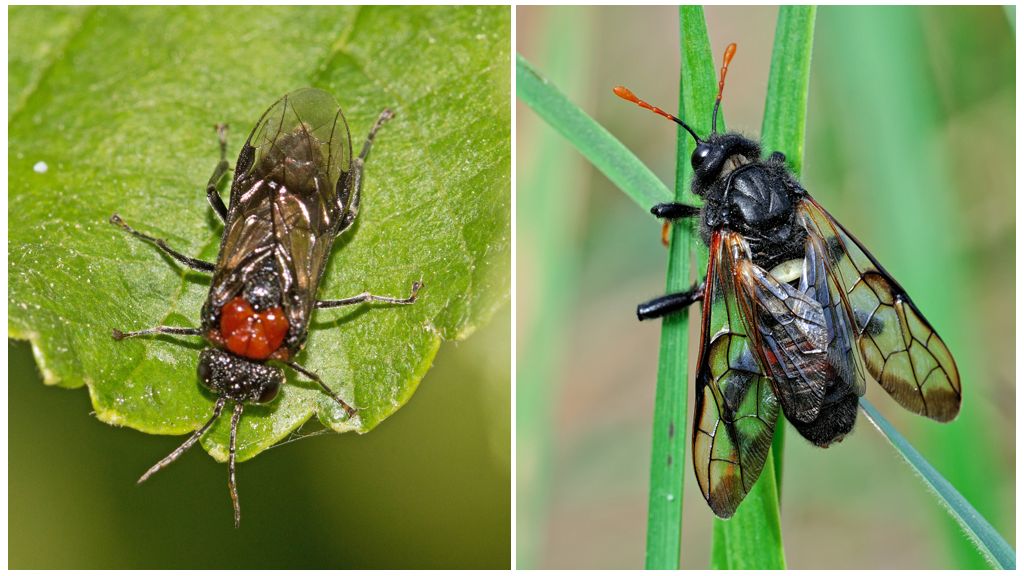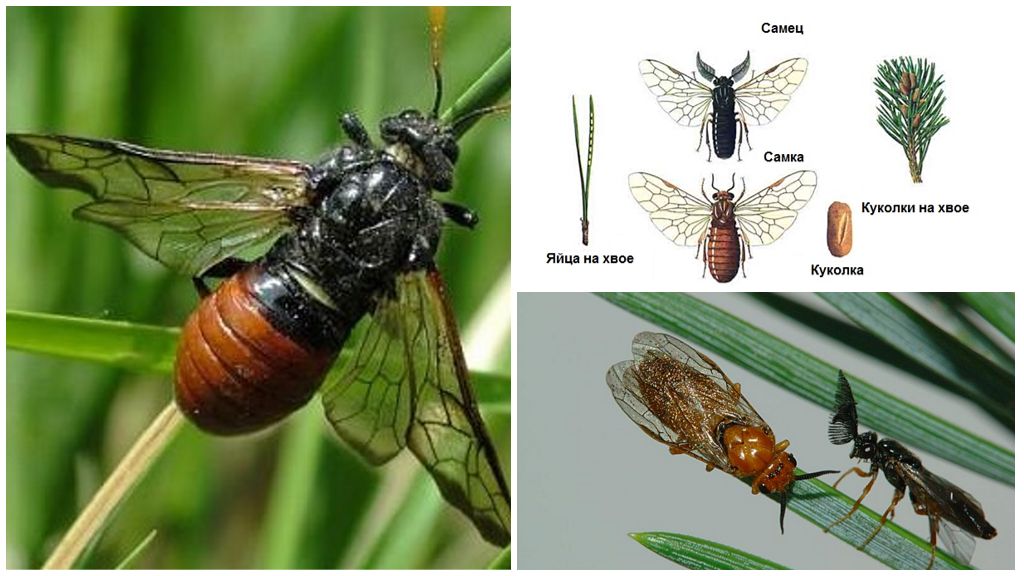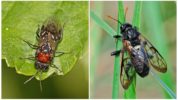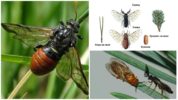- Beetle sawfly
- Beetle sawfly
Representatives of the eriocampa family - the Latin name of the sawfly, belong to the order Hymenoptera and are more reminiscent of large fliesthan beetles. Another name for the grinder, like the first, indicates a way of laying eggs. The female insect has an ovipositor in the form of a file, with which she cuts the sheet and lays her children in the resulting pocket.
Habitat
Insect sawflies are common in almost all continents. Most representatives of this pest inhabit territories with a temperate or cold climate. But some species are found in countries of South America, Australia, Asia. In Russia, they can be seen in the moist and shady forests of Siberia, the Caucasus, the European part of the country.
On a note!
Only in hot and dry climates is meeting with sawflies unlikely.
There are more than 2 thousand varieties of these beetles. By their name, it is easy to guess which plants they prefer:
- fruit;
- red pine;
- birch;
- plum;
- rosanny;
- bread;
- yellow gooseberry;
- pear weaver and others.
Description of appearance
The sawfly beetle, depending on the species, can have sizes from 2-3 mm to 3 cm, but two-centimeter individuals are more common. This type of insect belongs to the suborder of peritoneum, which characterizes its dense body, not separated from the head by a thin isthmus. Therefore, they can resemble small bugs that are not covered with a dense shell. Instead, two pairs of large elongated transparent wings flaunt on the back. In some sawflies, they folded apart in the same way as in an ordinary fly, in others they lie on top of each other.

The sawfly's head is large and mobile, there are two large eyes, on the top of the head are a long mustache with bristles. The jaws of the insect are well developed in order to gnaw at them leaves, needles and even bark of trees.
On a note!
The color of the abdomen of the pest, depending on the variety, can vary from black and dark brown to emerald green, orange and yellow. Numerous photos of the sawfly beetle clearly demonstrate their great variety of appearance.
Developmental stages and nutrition
An adult beetle appeared in spring from a pupa and immediately begins to absorb soft, tender greens. Gaining strength and nutrients, sawflies mate and prepare to give offspring. The female pest chooses a suitable place for masonry. This is usually a leaf of a tree or needles. Making a microscopic incision with his ovipositor, the insect lays eggs in a small cavity, where they are located for about 10 days. Then from them appear larvae - small false caterpillars. They are so called because they have a different number of eyes and limbs, unlike most types of caterpillars.
Interesting!
During danger, the larva of the sawfly beetle begins to behave unusually - it simultaneously raises the hind and forelimbs. Certain species release toxic fluid from the mouth. These secretions can cause an allergic reaction to human skin.
Light green or yellow larvae of the beetle with great appetite absorb the soft tissues of plants, sometimes they can go to young shoots and tree bark.They creep in flocks from one branch to another, leaving damaged leaves folded into a tube or yellowed and gnawed needles. In the conditions of warm summer and an abundance of plant food, larvae by August or September reach a length of more than 4 cm and are ready to pupate. To do this, they find a secluded place on a tree or slide down the trunk to dig into the fallen foliage.
Further development of the larva has two ways:
- After 2-3 weeks, an imago appears from the pupa, ready for a new development cycle. So during the season, the forest can suffer twice from the activity of these insects.
- The sawfly larva can feel the approach of colds and remain in the pupal stage until next summer. And in case of adverse conditions, the pupa is in the ground for up to 2 years, waiting for the onset of the long-awaited heat.

Beetle and Larva Methods
Any gardener and forestry worker is well acquainted with harmful insects. To understand what exactly the sawfly began to host in the trees, it is enough to carefully look at the crown of the tree. On the leaves, traces of the activity of the larvae look in the form of small paths and holes - mines, which are tunnels gnawed by voracious caterpillars. On conifers, needles have convex places - galls.
After such lesions, the leaves and needles turn yellow and dry, and the tree loses the normal functioning of photosynthesis processes. If you do not start to counteract the pest in time, the plants may die.
At the initial stage of infection of a small tree or shrub, you can try to collect the larvae by hand. Before you deal with them by chemical means, for a start, you can use folk. Spray the crown of the tree with a solution of mustard, wormwood, tobacco or laundry soap. The same method is good as a preventative measure. In the neglected case, when the number of larvae is too large, spraying with organophosphorus agents, pyrethroids, and antiviral drugs will help. The most popular are:
- Chlorophos;
- Anabazine Sulfate;
- Metaphos;
- Virin diprion and others.
To prevent infection of neighboring plants, it is necessary to dig around the trunk of a diseased tree. To prevent a new wave of the next generation of sawflies, an adhesive ring is used. The trunk of the plant is coated with a special glue that does not lose its adhesive properties for a long time. Larvae of the sawfly beetle will hover down to the ground before the winter and fall into the trap.





